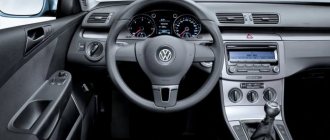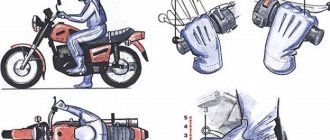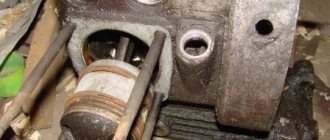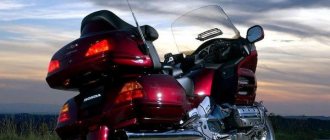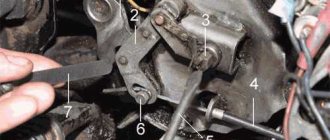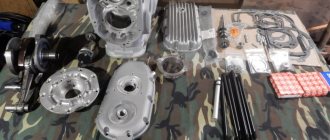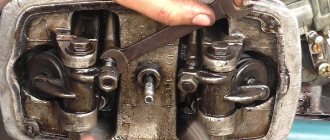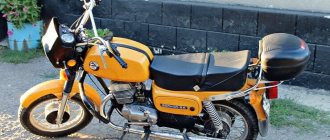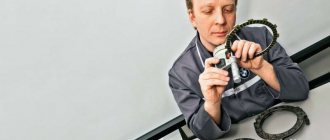Ural gear shift scheme can be different depending on the model of the Ural car. If we look at a Ural 4320 or Ural 5557 car with their modifications, we will see that a YaMZ 236U gearbox is installed there. It is three-way and has five forward and one reverse gears.
and is shown nearby. The gear drive installed in the box switches first gear and reverse gear. The remaining gears, namely second, third, fourth and fifth, are synchronized. It would be useful to see what the transfer case looks like. It has high and low gears, and you can also lock or unlock the differential.
If you have Ural 6563 or Ural 6470 cars, then the shift pattern on such Urals will be completely different, since they have a completely different gearbox installed. (see below). YaMZ 239 is mechanical, with a multiplexer, with nine stages, which have synchronizers. There is only one reverse gear and without synchronizers.
Gearboxes of Ural vehicles, regardless of the switching scheme, have proven themselves to be very positive. They are reliable and ensure that all necessary tasks are performed when driving, both empty and loaded, in any conditions, whether on the highway or off-road.
However, in order for such gearboxes to serve faithfully for many years, they must be properly maintained. Monitor the oil level; there is an indicator for this, which is located in the plug. Change it in time; for this there are two drain holes on the bottom and side. And fill it correctly according to the lubrication chart. If such a need arises, replace worn parts with new or repaired ones.
If it is necessary to tow a Ural car, then it is necessary to tow it correctly. If the distance exceeds 150 km and the engine is turned off, then it is necessary to remove the intermediate “cardan”. If you do not want to remove the intermediate driveshaft, the towing speed should not exceed 40 km/h.
Shift gears in the gearbox using the gear lever located to the right of the driver's seat.
Shift the lever with the clutch disengaged.
Press the clutch pedal sharply and fully. Change gears at minimum idle speed.
Start driving only from first gear (to avoid premature clutch failure).
To quickly accelerate a KamAZ vehicle on good roads and in difficult conditions, it is recommended to use all gears sequentially according to gear shift patterns.
For gearboxes of models 142, 144, 152, 154: Shift gears according to the diagram (see Fig. Gear shift diagram I).
It is recommended to use the entire range of low and high gears.
To switch from the highest “B” gear to the lowest “H” and vice versa (without shifting the lever), it is necessary to move the gear divider control switch to the desired position (see Fig. Gear shift diagram I) (on a car with a gearbox of models 142, 144 without there is no divider), and then press and release the clutch pedal after a short (1s) delay - the gear will engage automatically.
To simultaneously shift the lever and engage a higher or lower gear, set the divider control switch to the “B” or “H” position, press the clutch pedal and shift the lever.
Gear shift pattern I
For a model 152 gearbox with the possibility of using a power take-off box on the top hatch and on the flywheel housing, change gears according to the diagram (see Fig. Gear shift diagram II).
Gear shift pattern II
For gearboxes of models ZF - 9S109 and ZF - 9S1310, gear shifting is carried out according to the diagram (see Fig. Gear shift diagram in the gearbox of models ZF-9S109 and ZF-9S1310):
- 1-2-3-4-lower gears (lowest range of multiplier);
- 5-6-7-8-high gears (highest range of range).
How to shift gearbox on a Ural motorcycle
Power transmission of the motorcycle Ural
IMZ-8.103-10
Ural motorcycle gearbox shift mechanism
IMZ-8.103-10
The gear shift mechanism is shown in Fig. 16. Gear shifts occur in a certain sequence. When you press the front shoulder of the pedal, lower gears are sequentially engaged, and when you press the rear shoulder, higher gears are engaged.
The neutral position of the shift mechanism is fixed between 1st and 2nd gears; in this position, the warning lamp on the instrument panel should light up.
The reverse gear engagement mechanism consists of a sector 10 with a roller and a reverse gear pedal 9 attached to it and an intermediate gear mounted on a bracket that has longitudinal movement along the axis from the reverse gear sector.
When reverse gear is engaged, the intermediate gear moves with the bracket along the axis and connects the small ring of the starting gear with the ring of the clutch for engaging 1st and 2nd gears on the secondary shaft.
Reverse gear can be engaged from the positions: neutral and engaged 1st gear. When II, III and IV gears are engaged, the possibility of engaging reverse gear is excluded.
When the right pedal is turned one third of the entire stroke, the gear shift mechanism is set to the neutral position, while the bracket with the intermediate gear does not move and the entire mechanism is set to the neutral position. With further rotation of the reverse gear sector, the bracket with the intermediate gear will move along the axis, reverse gear will engage and at the same time the forward gear shift sector will be blocked - the possibility of engaging two gears will be eliminated.
Returning the pedal to its original position will set the shift mechanism to the neutral position.
Rice. 16. Gear shift mechanism: 1—pedal; 2 - dog with a leash; 3 — return spring; 4 - ratchet; 5 — pawl crank with finger; 6 — retaining ring; 7 — sector roller spring; 8 — sector roller; 9 — reverse pedal; ]0 — reverse gear sector; 11—gear shift sector; 12 — axis of the intermediate gear bracket; 13 — fork roller; 14 — fork for shifting III and IV gears; 15 — fork for shifting 1st and 2nd gears; 16 — nut for fastening the pawl crank lever; 17 — pawl crank lever; 18 — bushing; 19 — oil seal
Source
How to assemble and install
Box assembly procedure:
- compress the bearing;
- insert a chisel into the gap between the end part of the inner bearing ring and the differential box;
- install the bearing and axial mechanism of the satellites;
- insert the support ring into place;
- install drive gears and differential box;
- tighten the fasteners;
- install the synchronizer blocking ring;
- install the sliding clutch and retaining ring of the synchronizing device hub;
- install the driven gear and thrust washer;
- adjust the gap between the front bearing ring and the drive gear.
How to change speeds
I add hell for example!
I already opened it, but it’s only about repairs and installation.
in this case it is better not to buy.
From a scooter straight to the Urals, you’re desperate. My advice is to take with you someone who at least understands a little about them and has ridden them of course. In principle, there is nothing complicated, but there are some nuances, it’s better not to risk your life. Do you have a license? If not (most likely, otherwise I don’t think there would be such questions), it’s better not to go on public roads. Practice somewhere in the village, in garages, etc.
Where does a 16 year old pioneer get his license? ))
I also switched from a scooter to the Dnieper, however, then it almost didn’t go)
the first all the way down, then up in order neutral, second, third, and fourth. Down, respectively, you press not the front shoulder of the pedal up to the rear.
My pleasure. It’s better not to risk it yourself, let someone who knows how and with a license overtake it. Then you yourself will master driving in a large open area; the difference between a Ural and a scooter is big.
Congratulations on your decision to buy a Urals! A lot of new and wonderful things await you) in addition to everything said above, yes, it’s better to ask someone who knows how to drive to drive. you'll learn on your own later. When I bought my first IZH (I still didn’t have a license), I had to drive more than 100 km, and miraculously I didn’t fly under a car at the first intersection. but the miracle might not have happened. but he was a friend with rights)
CLUTCH. Don't forget to squeeze the clutch (lever on the left of the steering wheel) when changing gears)))
Yes, I know that, I just didn’t understand where to switch the foot (and without a clutch it would have been funny)))
The best way to change gears is with your foot.
and press the clutch by hand...
and most importantly, think with your head.
Find the instructions for the Ural 67-36 motorcycle and everything will be indicated there in detail - which gear corresponds to which speed. If you don’t find it, remind me, I’ll tell you then. I'm at work right now and don't have the instructions at hand.
Thank you, I already understood everything in principle.
So you can’t really tell a newbie what he’s asking for, he’ll take it and crash into you. There’ll be no one to blame. It’s my own fault for not prompting him in time. You need to be more attentive to newcomers.
Before you try to ride (if it's a solo ride), put the bike on the ground and try to lift it off the ground. Otherwise, God forbid, you fall and then you won’t pick him up
And with a stroller, even more so, you need to be more experienced in driving, since a single driver and a stroller are slightly different in control and behavior on the road.
hmm. driving license as I remember on cat. A can be opened from the age of 16.
FIRE is simple. No comments.
Don't forget to take with you a supply of motor oil, spare spark plugs, some tools, a helmet and a motorcycle license. And as much money as possible.
Kherivoznait, but for the first time in a wheelchair for me it was hellish torment. It was somehow easier on the Wolf the first time.
By the way, what are you going to do with the motorcycle later?
Maybe I’ll repair it and go to the dacha.
No, I was just hoping for a chopper.
O my young friend. Just because you're studying doesn't mean you already have them. So, first get a license, then say what you have. And it’s not a fact that you’ll get it. Z.Y. In general, you don’t have a license yet, and you definitely won’t for two years)))
Remind me about the clutch.
Finding neutral is very simple, you put it in first, and if there is a reverse gear, turn it on and off, that's all)))
Operating principle and troubleshooting of the Ural gearbox
The Ural gearbox is a device in the vehicle system that is responsible for transmitting power.
How does the checkpoint work?
The KPP-141 device, installed on some Ural models, includes the following elements:
The gears rotate freely when the neutral mode is engaged, at which time all clutches and synchronizers are in the open position.
When the driver begins to squeeze the clutch mechanism and shifts the handle to some other gear, a special fork device begins to move the clutch into the engagement position with the corresponding pair at the end of the gear.
The gear mechanism is rigidly fixed to the shaft and stops spinning on it. The clutch in this position facilitates the transmission of rotational motion and traction force.
While the vehicle is moving, the gearbox is activated by the gear shift knob. It moves sliders equipped with forks, which begin to move the synchronizers at the required speed. A color diagram of gear shifting is in the Ural user manual.
Gear ratios of the Ural box:
Malfunctions and repairs
Basic malfunctions and repairs of the box:
Gearbox repairs are carried out only with the power unit turned off.
How to adjust
The gearbox is adjusted as follows:
How much oil to fill
Oil must be added in accordance with the user instructions. For Ural cars, the sufficient oil fluid level is 3.5-4 liters.
How to remove and disassemble
In order to dismantle and disassemble the gearbox, you must:
How to assemble and install
Box assembly procedure:
Installation of the gearbox in the Urals is carried out as follows:
How much does the box cost?
The average cost of a box in the Urals is 80,000 rubles.
Ural motorcycle gearbox gear ratios
MOTORCYCLE GEARBOX “URAL”, “DNEPR”
On motorcycles “Ural” and “Dnepr” K-650 a two-way four-speed gearbox model 6204 is installed. On motorcycles “Dnepr” MT9, MT10-36, MV-750M MV-650, “Dnepr-12” a two-shaft four-speed gearbox with reverse gear is installed and an automatic clutch release mechanism of the MT804 model.
All models of road motorcycle gearboxes have constant gear ratios in all four forward gears: 1 - 3.6 (36/10), 2 - 2.28 (32/14), 3-1.7 (29/17) , 4-1.3 (26/20). The gear ratio is obtained by dividing the number of teeth of the driven gear (secondary shaft) by the number of teeth of the drive gear of the primary shaft.
GEARBOX OF MOTORCYCLES “URAL”, K-750 AND K-750M
The gearboxes of the Ural and K-750, K-750M, K-650 motorcycles (Fig. 4.9) of the Kyiv Motorcycle Plant are unified. Since 1980, modernized gearboxes began to be installed on Ural and Dnepr motorcycles. The cam clutches on the secondary shaft were replaced with splined ones, the external parts of the gear shift mechanism were changed into a closed crankcase cavity and isolated from dirt getting on the working surfaces. Replacing claw clutches with splined ones has significantly reduced the possibility of self-disengaging gears. Placing all parts of the switching mechanism in closed cavities significantly reduced their wear, increased the reliability and durability of the mechanism. New models of Ural motorcycle gearboxes are created on the basis of previously existing ones through repeated modernization. The gearbox model with reverse gear, produced since 1987, has much in common with the previous one.
The gearbox housing consists of: crankcase 3, front covers 1, left 11 (Fig. 4.9) and right 19 (Fig. 4.10). The crankcase and front cover are load-bearing parts that absorb the main loads during operation of the gearbox. They contain shaft supports. The left and right covers are attached to the crankcase, on which the gear shift mechanism is mounted.
How to remove and disassemble
In order to dismantle and disassemble the gearbox, you must:
- Place the vehicle on a lifting device or inspection pit.
- Remove the batteries, air filter element and mudguards. They are located at the bottom of the engine compartment, in the center and along the edges.
- Remove the front suspension cross member and the front drive wheel drives.
- Drain the transmission fluid from the box.
- Disconnect the wires of the sensor responsible for speed indicators. To do this, you need to pry up the wires with a screwdriver and carefully remove the spring retaining device.
- Remove the vehicle reverse switch.
- Remove the engine harness holder.
- Remove the mounting bolts from the gearbox and the hydraulic clutch release bracket.
- Remove the bolts from the working cylindrical block, clutch housing, amplifier.
- Remove the crankcase.
- Place a support under the dismantled box.
- Disconnect the front and rear supports from the bracket.
- Move the gearbox back and place it on a hard surface.
- Unscrew the fasteners and disassemble.
Technical characteristics of modern models [edit | edit code]
Tourist, Tourist 2WD, Gear-UP, Troika Lux [edit | edit code]
| Tourist | Tourist-2WD | Gear-UP | Troika Lux | |
| Model: | IMZ-8.1037 Tourist | IMZ-8.1037 Tourist-2WD | IMZ-8.1037 Gear-UP | IMZ-8.1037 Troika Lux |
| Dimensions L×W×H, mm: | 2580×1700×1100 | 2580×1700×780 | 2580×1700×1100 | |
| Ground clearance, mm: | 125 | |||
| Dry weight, kg: | 350 | |||
| Total weight, kg: | up | |||
| Fuel tank, l: | 19 | |||
| Maximum speed, km/h: | 105 | |||
| Fuel consumption in the city, l/100 km: | 6-7 | |||
| Fuel consumption on the highway, l/100 km: | 4-5 | |||
| Engine: | 745 cm³, 42 l. p., 4-stroke, 2 cylinders, opposed OHV | |||
| Launch: | electric starter and kickstarter | |||
| Electrical system: | 12 V, generator 500 W | |||
| Ignition system: | contact | |||
| Checkpoint: | 4-speed, with reverse | |||
| Main gear: | gimbal | |||
| Gear ratios: [15] | I - 3.6; II - 2.62; III - 1.61; IV - 1.3; Rear: 4.2 | |||
| Main gear ratio: | 4,62 | |||
| Tires: | 4.00x - 19″ | |||
| Wheels: | knitted, painted, 19″ | spoked, chrome-plated, 19″ | knitted, painted, 19″ | spoked, chrome-plated, 19″ |
| Brakes: | front - hydraulic, disc; rear - drums | |||
| Suspension: | front - lever with spring-hydraulic shock absorbers; rear - pendulum with spring-hydraulic shock absorbers, adjustable for load | front - telescopic; rear - pendulum with spring-hydraulic shock absorbers, adjustable for load | ||
| Seat: | separate, double adjustable | solid | separate, double adjustable | solid |
| The package includes additional equipment: | Painted stroller wheel rack, driver's mudguards, passenger handles, parking brake | Chrome-plated rack for the stroller wheel, searchlight, driver's mudguards, stroller glass, shovel, canister, chrome-plated driver's protective bar, chrome-plated stroller protective bar | Stroller wheel rack, searchlight, shovel, canister, driver's mudguards, passenger handles, parking brake, driver's protective bar, stroller's protective bar | Chrome-plated luggage rack on the stroller wheel, chrome-plated passenger handles, velor upholstery of the stroller, leather passenger seat in the stroller, stroller glass, parking brake, driver's roll bar |
Retro, Retro-Solo, Wolf, Solo-sT [ edit | edit code]
| Retro | Retro Solo | Wolf | Solo-sT | |
| Model: | RETRO | RETRO SOLO | WOLF | Solo-sT |
| Dimensions L×W×H, mm: | 2224×1630×1020 | 2224×840×1060 | 2530×850×1300 | n/a |
| Ground clearance, mm: | 140 | 115 | 125 | |
| Dry weight, kg: | 343 | 220 | 260 | 198 |
| Total weight, kg: | 610 | 400 | 430 | n/a |
| Fuel tank, l: | 19 | |||
| Maximum speed, km/h: | 120 | 150 | ||
| Fuel consumption in the city, l/100 km: | 6-7 | 5-6 | ||
| Fuel consumption on the highway, l/100 km: | 4-5 | |||
| Engine: | 745 cm³, 42 l. p., 4-stroke, 2 cylinders, opposed OHV | |||
| Launch: | electric starter and kickstarter | |||
| Electrical system: | 12 V, generator 500 W | |||
| Ignition system: | microprocessor | |||
| Checkpoint: | 4-speed, with reverse | |||
| Main gear: | gimbal | |||
| Gear ratios: [15] | I - 3.6; II - 2.28; III - 1.56; IV - 1.19; Rear: 4.36 | |||
| Main gear ratio: | 4,62 | 3,89 | ||
| Tires: | 110/90-18″ | front 90/90-18″ rear 130/90-16″ | front 3.50-18″ rear 4.00-18″ | |
| Wheels: | spoked, chrome-plated, 18″ | spoked, chrome-plated, 18″ | spoked, chrome plated | spoked, chrome-plated, 18″ |
| Brakes: | front - hydraulic, disc; rear - drums | front - hydraulic, disc; rear - hydraulic, disc | front - hydraulic, disc; rear - hydraulic, disc | |
| Suspension: | front - telescopic; rear - pendulum with spring-hydraulic shock absorbers, adjustable for load | front - telescopic; rear - pendulum with spring-hydraulic shock absorbers, adjustable for load | ||
| Seat: | separate, double adjustable | separate, double adjustable | separate | separate |
| The package includes additional equipment: | Velor upholstery of the stroller, leather passenger seat in the stroller, stroller glass, parking brake, driver's roll bar | Driver safety bars | ||
KamAZ gear shift diagram: features and recommendations
Starting off is carried out in a low gear. Shifting is carried out only when the clutch is disengaged. The KamAZ gearshift diagram on the ZF gearbox involves switching in several stages. This is expressed in the features of upshifts and downshifts. Thus, the car can move quickly on various types of road surfaces. The optimal pattern is considered to be 1B-2B-3B at the first stage, 4H-4B-5H during the subsequent movement. Based on this diagram, you need to start from the first low gear, i.e. you do not need to change the position of the lever on the gearbox until the 4th gear. In order for the car to start, it is necessary to increase the crankshaft speed to 7 thousand revolutions. The second gear is engaged when the rotation speed reaches 3000 rpm (number 3 on the tachometer).
It should be noted that the operation of the crankshaft in KamAZ vehicles plays a key role. If you change gears in time, you can significantly reduce fuel consumption and ensure economical engine operation without significant downtime.
Engine
Engine type – four-stroke two-cylinder. Brand – M-72M. Cylinder diameter, mm – 78. Piston stroke, mm – 78. Working volume, cm³ – 746. Compression ratio – 5.5 ± 0.2. Maximum power, l. With. – 22. Maximum torque, kg m – 4.0. The block head material is aluminum alloy. Head gasket – asbestos metal 0.6 mm. The piston material is aluminum alloy.
Valve distribution phases (according to the angle of rotation of the crank), degrees: – beginning of intake to c. m.t. – 76; – end of inlet after n. m.t. – 92; – beginning of release BC m.t. – 116; – end of release after c. m.t. – 52.
Carburetor – Two K-37.
Design of the reverse gearbox MTZ-80 and MTZ-82
A reverse gearbox is located between the clutch housing and the gearbox. This unit is responsible for quickly changing the direction of movement from front to rear.
The reverse gearbox consists of two units: a block of shafts and gears, as well as a gearbox control unit. A drawing of the reverse gearbox can be seen in the figure below:
The numbers in the figure indicate:
- reverse gear cover;
- synchronizer;
- lever;
- roller with fork;
- retainer ball;
- cup;
- sleeve;
- gearbox input shaft;
- driven gear;
- Transmission;
- front socket;
- clutch housing;
- idler gear;
- satellite axis;
- pin;
- satellite;
- ball bearing;
- power shaft;
- drive gear;
- lid;
- parallelogram mechanism;
- reverse gear control lever.
The transmission of a car is closely related to the type of engine. For Ural cars, the gearbox versions changed along with the engines.
Chronology of checkpoint compliance
Ural 4320, Ural 5557, until 1994, the KAMAZ 141 gearbox was installed, which was installed for the KAMAZ 740 engine. Since 1994, the Urals have been equipped with YaMZ 236 engines with the corresponding YaMZ 236 gearbox, YaMZ 2361 gearbox
Today, most Ural vehicles are equipped with YaMZ 206 gearboxes and its modifications. The YaMZ 206 gearbox is mechanical, three-way, five-speed with synchronizers in 2nd and 3rd, 4th and 5th gears.
Valve adjustment for Ural M-67, IMZ
On this engine the recommended clearance is 0.05mm.
Therefore, you will need a probe with exactly this thickness. It also has slightly different saddles, but this does not affect the adjustment process. The motorcycle should also be tilted before starting work. The process occurs as follows: This is how you can easily and quickly adjust the valves. This work is not difficult, but it will avoid many problems with the engine. Also, with properly adjusted valves, flow is reduced.
Source
Transfer case Ural 4320, design and operation
Today we will talk about the transfer case of the Ural 5557 and 4320, and also discuss their design.
The transfer case is a unit that is responsible for distributing torque from the engine to certain drive mechanisms, and they most often increase the number of gears in the transmission.
The Ural transfer case distributes torque between the axles and increases the torque of the drive wheels, which guarantees stability while the Ural vehicle is moving.
The Ural transfer case significantly affects the cost of the fuel mixture and the traction and speed parameters of the vehicle.
Because of this, the cost of transporting various cargo directly depends on the correct choice of parameters owned by the transfer case itself.
In this article you can easily find answers to the most common questions:
Basic information about the transfer case of the Ural 5557 and 4320
The Ural 4230 and 5557 vehicles use a two-stage transfer case equipped with an asymmetrical cylindrical center locking differential with a power drive. The transfer case is mounted on the car frame using four rubber pads. The design of the transfer case of the Ural 5557 and 4320 is absolutely the same as that of the KamAZ 4310.
In the middle of the crankcase the following are located on bearings:
In order to maintain atmospheric pressure in the crankcase cavity, a fitting with a tube is installed on the bearing cover, connecting the crankcase to the atmosphere through a sealing system. The outlet tip of the tube is brought to a level above the maximum fordability to prevent water from being sucked into the crankcase while overcoming water obstacles.
The crankcase is made of cast iron, there is a hatch on top, the crankcase itself is one-piece, closed with a lid with an oil guide tray.
Oil is poured into the crankcase through the top hatch with the cover removed or through the hole under the control plug, which is located on the rear wall of the crankcase. The oil is drained through the bottom hole, which is closed with a plug with a magnet.
The crankcase is ventilated using a fitting, and its tube is included in the general sealing system of the units.
Transfer case Ural 4320
How does the transfer case Ural 4320 and 5557 function?
In the Ural 4320 and 5557, the torque supplied to the drive wheels can change.
That is, the transfer case is considered at the same time an additional gearbox, which increases the number of gears and the limits of change in the gear ratio in the transmission.
Thanks to the inclusion of a low gear in the gearbox and transfer case Ural 4320, 5557, it is possible to overcome high resistance to movement and stable movement of the machine at low speed.
The Ural 4320 and 5557 boxes with a rigid connection between the drive rollers of the drive axles have a ratio of torques that are supplied to the main gears of the drive axles, depending on certain parameters of the machine design and driving conditions.
With the drive locked and driving straight on roads with good grip but little resistance and differences in wheel radii, certain drive wheels may slip and slide.
This leads to faster wear of tires, transmission units and additional loads.
In order to eliminate these undesirable phenomena, a differential drive is used in this part.
In this case, the torque is distributed between the drive rollers of the drive axles using a differential, which allows these rollers to rotate at angular speeds different from each other.
Thanks to the properties of the installed differential, torque is distributed between the drive axles. That is, thanks to the transfer case differential, costs are reduced while driving on the roads.
Although the use of a drive differential while driving on slippery roads that have little grip can lead to a decrease or loss of vehicle maneuverability. To increase cross-country ability, vehicles are equipped with a device that blocks the differential.
Common malfunctions of the transfer case Ural 4320, 5557
Ural 4320 and 5557 boxes may have the following problems:
We hope that our article gave you all the answers to your questions and now you have gained basic, basic knowledge on this topic. Good luck on the road and follow the traffic rules!
Did you like the article? Was she helpful?
How to change gears on a car correctly
If the truck begins to slip, then you need to stop moving as quickly as possible and immediately disable the differential axle. You can see the switch to turn it off on the dashboard.
When the differential axle is disengaged, a corresponding indicator will appear on the instrument panel. After this, the start of movement is carried out at increased speed, from second gear.
When you drive through a hard-to-reach section of the road, do not forget to engage the differential (video shot and published by Vladimir Nikonov).
How to correctly change the gearbox on a KAMAZ
The whole risk is not in the checkpoint, but in the STROLLER. Ask someone to move it. I once let a scooter driver steer my Dnieper-wheelchair, and we “drove” off the road into nettles—very cruelly.
He said that his steering wheel turned towards the stroller, he got scared, let off the gas, but forgot to press the brake and switch to a lower gear. Learn to operate a heavy motorcycle not on a public road.
How to change speeds
and is shown nearby. The gear drive installed in the box switches first gear and reverse gear. The remaining gears, namely second, third, fourth and fifth, are synchronized. It would be useful to see what the transfer case looks like. It has high and low gears, and you can also lock or unlock the differential.
Gearbox how to change speed diagram
However, in order for such gearboxes to serve faithfully for many years, they must be properly maintained. Monitor the oil level; there is an indicator for this, which is located in the plug.
Change it in time; for this there are two drain holes on the bottom and side. And fill it correctly according to the lubrication chart. If such a need arises, replace worn parts with new or repaired ones.
A few tips for learning how to change gears correctly on a manual transmission while driving.
There are many models of scooters. The most common are models with an engine capacity of up to fifty cubic centimeters.
Such devices do not require a full category “A” driver’s license, which means you will save on insurance and mandatory technical inspection. Plus, you won't have to pay road tax.
Focus on this when you choose a kitchen series motorcycle model or a scooter. More powerful models should be considered only after full training in driving smaller vehicles.
How to change gears on a Ural motorcycle
This is the peculiarity of driving a KamAZ vehicle. A gearbox, the shift pattern of which is well studied and executed in this form, is distinguished by directional stability.
The main point of dividing it into 2 modes is to facilitate engine operation when driving a car with different weights.
Starting off on a loaded KamAZ (or with a trailer) is carried out in high gear with a crankshaft speed of 2600 rpm.
KamAZ gear shift diagram: features and recommendations
In this case, the cone ring of the housing is pressed against the gear cone. Due to friction between the conical surfaces, the housing rotates and the depression of the slot hits the coupling pin, locking it with the housing. As a result, the housing cone is pressed firmly against the gear cone by the force applied to the gear lever.
Due to the strong friction that arises between the speed cones, the gears and couplings align with the shaft, and the locking device releases the coupling from the synchronizer body. The clutch, squeezing the clamp balls, moves further. In this case, its ring gear engages with the internal teeth of the gear, including the gear.
Separately, it should be said about the rules for towing a Ural car. When the distance exceeds 150 kilometers and the engine is running, it is important to remember to remove the intermediate driveshaft. If you do not want to remove the intermediate universal joint, then towing should be done at a speed not exceeding 40 kilometers per hour.
Gearbox for the Urals
Among the most common mistakes that novice drivers make, it should be noted that they do not operate the gearshift lever smoothly, which is why the car loses speed. In this case, switching is usually scattered and abrupt, which causes damage to some components of the box.
How to change gears on a motorcycle correctly
All movements you make with the pedals must be smooth so as not to damage the transmission.
When changing gears, change one speed at a time. It is not advisable to jump.
To understand how to change gears on a motorcycle, you need to carefully study the controls. There are motorcycles with manual transmission and semi-automatic.
Gear shifting methods
Method one
Motorcycles with manual transmission. All actions in this case occur in the following sequence. Pick up speed. Take off the gas. Engage the clutch. Press the gear shift pedal. Release the clutch, then the shift pedal and add gas.
To start the motorcycle, place it in neutral. After this, remove the gas and squeeze the clutch, at the same time turning on first gear. Taking your foot off the gear pedal, apply gas and release the clutch. Now add gas.
To upshift, you need to lift the gas, engage the clutch and press the gearshift pedal. After this, release the clutch, release the shift pedal and add gas.
To downshift, you need to remove the gas and engage the clutch. After this, sharply add gas, and when the speed begins to drop, press the gearshift pedal. Release the clutch and shift pedal and add gas. Once the motorcycle has stopped, be sure to put it in neutral.
Method two
Motorcycles with semi-automatic transmission. On these motorcycles, gear shifting is easier. Take off the gas and change gears. The clutch and gearbox are connected here.
Before starting the engine, place your bike in neutral. In order to engage first gear, you need to remove the gas and press the gear lever down. To increase the gear, you need to remove the gas and lift the gear lever up. To downshift, on the contrary, you need to apply gas and immediately remove your hand from the gas. When the speed starts to drop, change the speed and add gas. Now you know how to change gears on a motorcycle.
Read more: Engine resource reviews
Control mechanism and devices URAL-4320-10, URAL-4320-31
The Ural 4320 is a popular truck that is excellent for use on rough terrain and in forestry. This is facilitated by high ground clearance and a powerful engine. This machine is equipped with YaMZ diesel engines. Power can exceed 300 horsepower. The gear shift scheme is competently designed by the manufacturer of this equipment. Approximately 30 liters of fuel are consumed per 100 km. If this indicator has increased, it is necessary to carry out premature diagnostics of the automotive system.
The winch for the Ural-4320 is necessary for self-pulling vehicles or pulling out other vehicles. Maintenance of the winch consists of directly checking and tightening all fasteners.
Technical characteristics of modern models [edit | edit code]
Tourist, Tourist 2WD, Gear-UP, Troika Lux [edit | edit code]
| Tourist | Tourist-2WD | Gear-UP | Troika Lux | |
| Model: | IMZ-8.1037 Tourist | IMZ-8.1037 Tourist-2WD | IMZ-8.1037 Gear-UP | IMZ-8.1037 Troika Lux |
| Dimensions L×W×H, mm: | 2580×1700×1100 | 2580×1700×780 | 2580×1700×1100 | |
| Ground clearance, mm: | 125 | |||
| Dry weight, kg: | 350 | |||
| Total weight, kg: | up | |||
| Fuel tank, l: | 19 | |||
| Maximum speed, km/h: | 105 | |||
| Fuel consumption in the city, l/100 km: | 6-7 | |||
| Fuel consumption on the highway, l/100 km: | 4-5 | |||
| Engine: | 745 cm³, 42 l. p., 4-stroke, 2 cylinders, opposed OHV | |||
| Launch: | electric starter and kickstarter | |||
| Electrical system: | 12 V, generator 500 W | |||
| Ignition system: | contact | |||
| Checkpoint: | 4-speed, with reverse | |||
| Main gear: | gimbal | |||
| Gear ratios: [15] | I - 3.6; II - 2.62; III - 1.61; IV - 1.3; Rear: 4.2 | |||
| Main gear ratio: | 4,62 | |||
| Tires: | 4.00x - 19″ | |||
| Wheels: | knitted, painted, 19″ | spoked, chrome-plated, 19″ | knitted, painted, 19″ | spoked, chrome-plated, 19″ |
| Brakes: | front - hydraulic, disc; rear - drums | |||
| Suspension: | front - lever with spring-hydraulic shock absorbers; rear - pendulum with spring-hydraulic shock absorbers, adjustable for load | front - telescopic; rear - pendulum with spring-hydraulic shock absorbers, adjustable for load | ||
| Seat: | separate, double adjustable | solid | separate, double adjustable | solid |
| The package includes additional equipment: | Painted stroller wheel rack, driver's mudguards, passenger handles, parking brake | Chrome-plated rack for the stroller wheel, searchlight, driver's mudguards, stroller glass, shovel, canister, chrome-plated driver's protective bar, chrome-plated stroller protective bar | Stroller wheel rack, searchlight, shovel, canister, driver's mudguards, passenger handles, parking brake, driver's protective bar, stroller's protective bar | Chrome-plated luggage rack on the stroller wheel, chrome-plated passenger handles, velor upholstery of the stroller, leather passenger seat in the stroller, stroller glass, parking brake, driver's roll bar |
Retro, Retro-Solo, Wolf, Solo-sT [ edit | edit code]
| Retro | Retro Solo | Wolf | Solo-sT | |
| Model: | RETRO | RETRO SOLO | WOLF | Solo-sT |
| Dimensions L×W×H, mm: | 2224×1630×1020 | 2224×840×1060 | 2530×850×1300 | n/a |
| Ground clearance, mm: | 140 | 115 | 125 | |
| Dry weight, kg: | 343 | 220 | 260 | 198 |
| Total weight, kg: | 610 | 400 | 430 | n/a |
| Fuel tank, l: | 19 | |||
| Maximum speed, km/h: | 120 | 150 | ||
| Fuel consumption in the city, l/100 km: | 6-7 | 5-6 | ||
| Fuel consumption on the highway, l/100 km: | 4-5 | |||
| Engine: | 745 cm³, 42 l. p., 4-stroke, 2 cylinders, opposed OHV | |||
| Launch: | electric starter and kickstarter | |||
| Electrical system: | 12 V, generator 500 W | |||
| Ignition system: | microprocessor | |||
| Checkpoint: | 4-speed, with reverse | |||
| Main gear: | gimbal | |||
| Gear ratios: [15] | I - 3.6; II - 2.28; III - 1.56; IV - 1.19; Rear: 4.36 | |||
| Main gear ratio: | 4,62 | 3,89 | ||
| Tires: | 110/90-18″ | front 90/90-18″ rear 130/90-16″ | front 3.50-18″ rear 4.00-18″ | |
| Wheels: | spoked, chrome-plated, 18″ | spoked, chrome-plated, 18″ | spoked, chrome plated | spoked, chrome-plated, 18″ |
| Brakes: | front - hydraulic, disc; rear - drums | front - hydraulic, disc; rear - hydraulic, disc | front - hydraulic, disc; rear - hydraulic, disc | |
| Suspension: | front - telescopic; rear - pendulum with spring-hydraulic shock absorbers, adjustable for load | front - telescopic; rear - pendulum with spring-hydraulic shock absorbers, adjustable for load | ||
| Seat: | separate, double adjustable | separate, double adjustable | separate | separate |
| The package includes additional equipment: | Velor upholstery of the stroller, leather passenger seat in the stroller, stroller glass, parking brake, driver's roll bar | Driver safety bars | ||
Malfunctions and repairs
Main faults and repairs of the Ural-4320:
How to disassemble a Ural-4320 wheel
According to the repair instructions, in order to disassemble a wheel in the Urals, you must:
How to separate the pads
In order to separate the pads, you need:
How to bleed the brakes
In order to bleed the brakes, you must:
Breakdowns and malfunctions of the brake system of the Ural-4320:
How to pump power steering
Procedure for bleeding the power steering:
How to remove the engine
In order to remove the engine from the Ural-4320, you need:
How to remove the gearbox
Transmission removal procedure:
How to adjust the clutch
The coupling mechanism is adjustable both on the dismantled device and as part of the vehicle.
Clutch adjustment is carried out as follows:
How to connect the ignition switch
The procedure for connecting the lock connections should only be carried out with the batteries disconnected.
It is necessary to install the key in the ignition lock in the zero position so that its head is in a horizontal position. After this, unscrew the 5 screws and disconnect the steering shaft from the plastic casing.
Using a small screwdriver, pull the lock towards you, find the faulty ones among the wires and replace them. After this, install all the parts in place and start the engine.
Source
